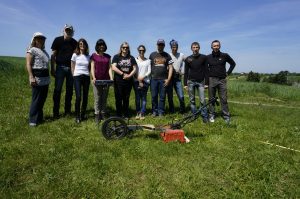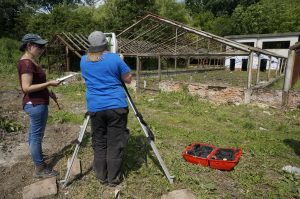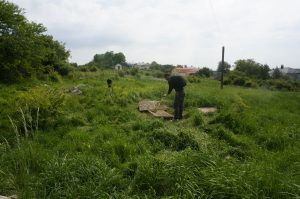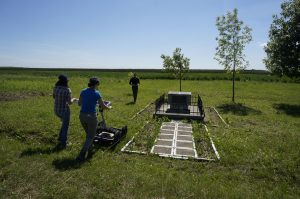- Field Survey Team at Rohatyn’s South Mass Grave Site (Photo credit: Jay Osborn)
- Total Station Survey at Rohatyn’s North Mass Grave Site (Photo credit: Jay Osborn)
- Photogrammetry survey at rohatyn’s old Jewish cemetery (Photo credit: Jay Osborn)
- Ground Penetrating Radar Survey at Rohatyn’s South Mass Grave Site (Photo credit: Jay Osborn)
For nine days from late May to early June 2017, Rohatyn Jewish Heritage commissioned the Centre of Archaeology to undertake a non-invasive professional survey at three WW2-era Jewish mass grave sites in Rohatyn. The 80-page final report written by our team is now accessible via Rohatyn Jewish Heritage’s website.
The project was commissioned by Rohatyn Jewish Heritage, a volunteer-led NGO that works to reconnect the history of Rohatyn’s now-lost Jewish community with the people and places of the modern town via heritage and education programs.The team also collaborated with the Cyprus Institute’s Science and Technology in Archaeology Research Centre, who provided scientific support for the project.
The survey focused on three sites in the town where witnesses suggest mass killings and burials were carried out. Approximately 3500 of the town’s residents were rounded up and shot at two pits to the south of the town on the 20th March 1942. Thousands more from Rohatyn and nearby towns and villages were killed in ad hoc executions throughout 1942-1943, and during the “Final Aktion” in June 1943. Rohatyn’s old and new Jewish cemeteries were both desecrated by the Nazis.
Within the surveyed areas, two mass grave boundaries were detected and defined (one at each location, north and south), and a third, possible grave was identified at the north site. An ongoing problem with criminal looting at the south mass grave site, and a mismatch between the current fenced perimeter of Rohatyn’s new Jewish cemetery and its pre-war boundaries as seen in the 1944 Luftwaffe aerial photo were also identified by the survey team.
The international archaeological team used a combination of non-invasive topographic and geophysical survey methods to map the sites and try to locate the mass graves without disturbing the ground. Photogrammetry techniques were also used to record a sample of the surviving headstones in both the old and new Jewish cemeteries. Volunteers from Rohatyn Jewish Heritage, the Lviv Volunteer Center and from the local community also carried out extensive cleaning operations in the new Jewish cemetery.
The work formed part of a wider project entitled “Recording Cultural Genocide and Killing Sites in Jewish Cemeteries” that focuses on raising awareness of the causes and consequences of cultural genocide and mass killings (using Jewish cemeteries desecrated by the Nazis as a pilot case study), directly tackling racism, xenophobia and hostility in the present.
The Centre of Archaeology will continue to collaborate with Rohatyn Jewish Heritage as new data is acquired, and Rohatyn Jewish Heritage will begin working with the City of Rohatyn in 2018 to explore options for better protecting these vulnerable sites from development and disturbance and for remembering Rohatyn’s Jewish victims.
The results of this non-invasive archaeological survey are available online.
Learn more about the Rohatyn Jewish Heritage program
Read more about the Recording Cultural Genocide and Killing Sites in Jewish Cemeteries Project or check out our Facebook page




